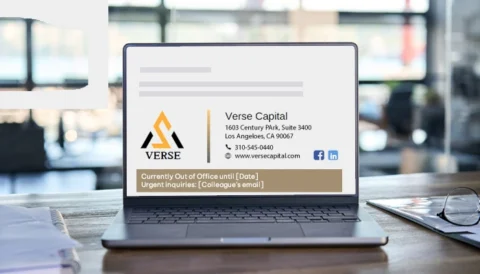A whole article on email signature fonts! Is there really that much to say? Perhaps surprisingly, YES there is, because from both technical and brand image perspectives (with a bit of font psychology thrown in), it’s vitally important you choose the best signature font for your business email if you want the right recipient response.

For example, have you ever wondered if your signature font could just be a bit, well, friendlier?
Of course, when creating an email signature, there are lots of different elements to consider and your chosen font is one of the most important ones. However, with so many fonts to choose from, how do you know which is the best font to use for email signature for your business?
Fortunately, this is something that our email signature marketing experts can help you with – from which fonts can be used in email signatures and best email signature font size, to which are the most professional email signature fonts and whether you should choose a ‘friendlier’ font. Keep reading to find out everything you need to know about how to choose the perfect font for your emails – and even a bit of font psychology!
Plus, look out for our favourite professional email signature font examples that will give you some much-needed inspiration for your email signature.
Risks of using the wrong email signature font
Content not being viewable on all email platforms
If your chosen font is not web-safe, it may not be available on all email platforms. If this is the case, the browser will fall back on a default font that could potentially ruin your entire email signature design
Risk of you or your business being portrayed as unprofessional, childish or too stylish
If you pick a font that is childish or too stylish, it can portray your business as unprofessional, and you may be taken less seriously than your competitors.
Content being illegible and unreadable
If your font is not legible, people may ignore the information provided in your email signature altogether.
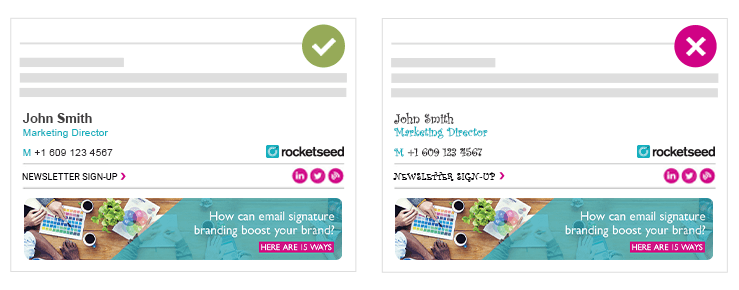
How to choose a professional font for email signatures
When selecting a font, you need to consider both its functionality and the potential psychological effect it could have on your target audience (I said there’d be a bit of font psychology)!
In terms of functionality, you need a font that is:
- Legible – i.e., one that is easy to read
- Web-safe – i.e., one that can be displayed on most computers, operating systems, and mobile devices
In terms of creating a positive impression, you need a font that conveys:
- Stability
- Maturity
- Reliability
You should avoid any fonts that evoke too strong an emotion as you cannot control how a font will make someone feel, and it may end up with them associating your business with a negative emotion.
You should also avoid any font that is too fanciful or intricate as not only can these be hard to read, but they can also make your brand seem less professional and less competent. For example, Comic Sans might be OK if you’re a kids’ party planner but it’s going to make your law firm look like clowns!
This is what a professional law firm email signature could look like:

The best fonts for email signature
As a general rule, if you want to adhere to the above, you need to pick a font that is either Serif or Sans Serif as these are both easy to read and are known for having a positive impact on readers.
The best email signature fonts are: Arial, Verdana, Georgia, Tahoma, Courier, Times New Roman, Trebuchet, Palatino and Lucida.

What email signature fonts should you avoid?
When it comes to the best font for an email signature, it can sometimes be a better idea to find out which fonts you should definitely avoid (it’s that font psychology again). You’ve worked hard to build up your professional brand image – don’t throw it all away with a fanciful font!
The below fonts are not suitable for a professional email signature and should never be used:
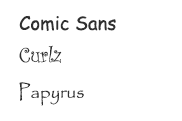
Other email signature fonts to avoid:
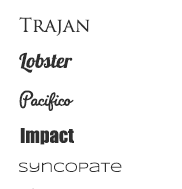
What is the standard font size for email signatures?
To ensure optimum readability, you should use 10-12pt typefaces for your email signature font. However, if you have any visually impaired customers, for any especially important details that you want to make prominent, you should increase this to 14pt.
Can you use Google fonts in your email signature?
Although Google does have an impressive selection of fonts that you can use for the email signature on Gmail, the problem with using one of these is that not everyone you send an email to will have downloaded that particular font onto their PC. This will result in part of your email signature not being visible.
Instead, you are better off sticking to one of the recommended fonts above that are used by 99% of email service providers worldwide.
What is a fallback font?
A fallback font is a typeface set as a reserve so that if the font you’re using or viewing can’t be used, isn’t available or is incompatible, a reserve “fallback” font is used. It is most frequently used when either the primary font face isn’t loaded, can’t be loaded or is non-websafe.
Fallback fonts for email platforms
Unless defined otherwise, the following are the default fallback fonts for different email platforms:
- Gmail: Arial
- Apple Mail: Helvetica
- Outlook: Times New Roman
Font compatibility
Are you interested in knowing more about which fonts are the most compatible for different operating systems? Here’s the most compatible font families for Windows, Mac, Linux and Ubuntu.
| Font Family | Mac OS | Windows | Mandriva Linux | Ubuntu | Ubunto with msttcorefonts |
| sans-serif | Helvetica | Arial | DejaVu Sans | DejaVu Sans | DejaVu Sans |
| Verdana | Verdana | Verdana | N/A | N/A | Verdana |
| Arial | Arial | Arial | Liberation Sans | N/A | Arial |
| Helvetica | Helvetica | Arial | Liberation Sans | Nimbus Sans L | Nimbus Sans L |
| Helvetica Neue | Helvetica Neue | N/A | N/A | N/A | N/A |
| Geneva | Geneva | N/A | N/A | N/A | N/A |
| DejaVu Sans | N/A | N/A | DejaVu Sans | DejaVu Sans | DejaVu Sans |
| Bitstream Vera Sans | N/A | N/A | Bitstream Vera Sans | Bitstream Vera Sans | Bitstream Vera Sans |
Practices for the best font for signature email
There are some dependable practices that you need to follow if you want the best font. This includes:
Select a web-safe font
Choose a font from the approved list above that offers safety and readability.
Ensure font is on-brand
Match your signature font as closely as possible to your company brand guidelines.
Use the right font size
Use 10-12pt font sizing for optimum readability.
Limit number of fonts used
Try to use a single font, and certainly no more than two, on your signature.
Use font style wisely
You can use bold or italics in your email signature to highlight important details but don’t overuse these styles.
Avoid bright or too light colours
Dark fonts such as black, dark grey, and brown are the best choices for an email signature. Light colours, such as yellow or pink, are hard to read, and bright colours can be distracting.
Employ font psychology
Does your signature font make the right impression? Does it make you look professional? Is it friendly enough?
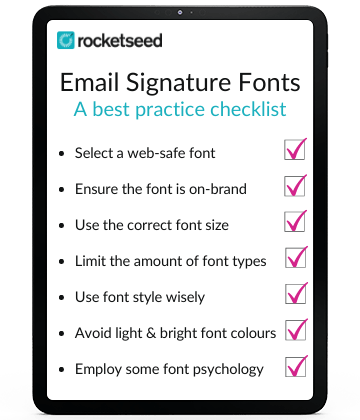
How friendly is your email signature font?
Perhaps now’s the time to start using a friendlier font? What got us thinking about this was the recent article by Arthur House in the Economist ‘How the pandemic made fonts friendlier’ who describes how “companies are ditching functional typefaces for cuddlier ones”.
In his article House observes that “Pandemic-era fonts” are characterised by curved lines and rounded shapes, citing a 2017 study that found curves and circles were perceived as softer, milder and ‘friendlier’ than the solidity and authority conveyed by straight lines and sharp angles.
Could your email signature font be more friendly? Perhaps it’s time to think about a curvier’ typeface to stay ahead of the curve in conveying a friendlier brand image of sustainability and diversity?
Should you use a custom font in email signature?
Custom fonts for email signature are fonts that are specifically created for a company. There are advantages and drawbacks to investing in a custom font for your business.
On the plus side, it can make you stand out from the crowd and showcase your individuality and creativity. However, as a custom font is most likely not installed on an external recipient’s device, the font may not show correctly on your email signature and will most likely change to a default font such as Times New Roman.
While it is possible to set the default font to one of your choosing, you will need to have a good knowledge of HTML coding to be able to do this.
The easiest solution is simply to choose the web safe font that is nearest to the typeface(s) specified in your corporate visual brand guidelines.
If you need further help choosing the best font for a professional email signature or any other aspect of email signature design, please get in touch with our friendly and knowledgeable team.



